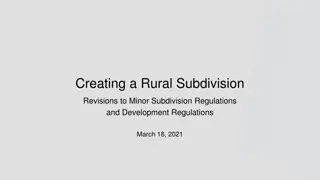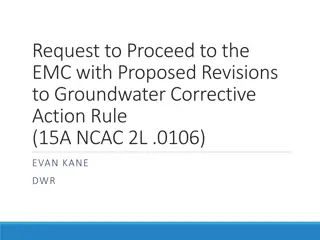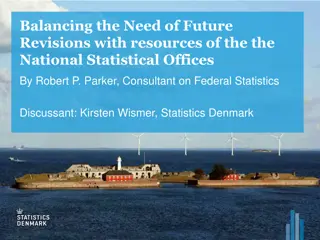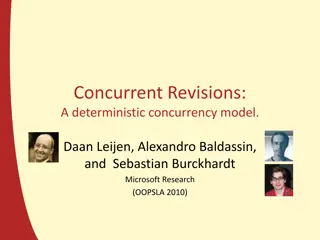
Revisions and Rebasing in Statistical Analysis
Explore the differences between revisions and rebasing in statistical analysis, reasons for revisions, the importance of a base year, recommendations for planning and performing revisions, and relevant changes in SNA 2008. Learn about the base year's significance, implementation of new classifications, and more.
Download Presentation

Please find below an Image/Link to download the presentation.
The content on the website is provided AS IS for your information and personal use only. It may not be sold, licensed, or shared on other websites without obtaining consent from the author. If you encounter any issues during the download, it is possible that the publisher has removed the file from their server.
You are allowed to download the files provided on this website for personal or commercial use, subject to the condition that they are used lawfully. All files are the property of their respective owners.
The content on the website is provided AS IS for your information and personal use only. It may not be sold, licensed, or shared on other websites without obtaining consent from the author.
E N D
Presentation Transcript
Revisions and Rebasing ASSD ASSD 2 2- -4 November 2016 4 November 2016 Tunis, Tunisia Tunis, Tunisia Samson NOUGBODOHOUE Statistician Statistics Division African Union Commission
Revisions/Rebasing of NA O Reasons for revisions / rebasings O What distinguishes revision from rebasing ? O What is the sense of having a base year ? O Recommendations for choosing the base year O Recommendations for planning and performing the revision O Recommendations for involving the users O Relevant changes in the SNA 2008 O Volume chain indices O The milestones for implementing SNA 2008 2
Main reasons for revisions O Conceptual Conceptual revisions revisions Revisions of SNA Other revisions O Revision of methods Improvements Correction of faulty ones methods O Implementation of new or updated classifications classifications O Implementation of new Additional sources, updated sources (e.g. censuses) Correction of faulty ones new data data 3
Revision or rebasing? O A revision usually includes the change of the base year. O A rebasing is not necessarily linked with revisions of concepts, methods and classifications, albeit in most cases it is. O There are two reasons that among the statistical offices the term rebasing is more popular than revision : revision in the sense of rebasing ( big revision ) may be confused with the annual revisions during the regular compilation cycle. rebasing sounds more technical and can in contrast to revision - not be misunderstood as a process of cleaning faulty figures the statisticians have to be blamed for. O The SNA does not use the term rebasing . 4
The sense of having a baseyear (1) O The base year is the starting point for the compilation according to concepts, classifications and methods which remain unchanged from that year onward. O The base year is also the base year for the volume indicators (figures at constant prices ). O If chain-linking is applied (as recommendd in SNA 2008) the base year is called the reference year for the chain volume series or chain volume index . 5
The sense of having a baseyear (2) O The base year is not necessarily the start year of long time-series. Statistical offices often also provide time- series prior to the base year by using bridge tables between subsequent releases of classifications. In case of changes of concepts definitions or methods often global coefficients or retropolations are used for the backcasting to satisfy the users needs for long time- series. 6
Recommendations for choosing the baseyear Choose a base year which in ideal case fulfills several criteria Choose a base year which in ideal case fulfills several criteria: O It should be a normal one : no extraordinary developments in the business cycle, no catastrophies, no droughts, no wars etc. O It should be the reference year for an economic census. O It should be close to censuses of agriculture, housing and population. O It should be close to the base year for price statistics (CPI, PPI). If constant prices are applied it would be easier to explain and to publish if both base years match. But technically it is not necessary. 7
Planning and performing a revision O The figures of the new time-series should be compiled in different steps according to the causes of revision. This will provide the impact of the different causes on the level of GDP and ist aggregates. The users will ask for it. O For the revision of methods and for choosing best practices test calculations would be useful. O There should be a strict documentation of the changes made, including the cleaning of faulty figures. O The release of the revised figures should go hand in hand with a detailed publication of the causes of the revision and their impact on the figures. O Special attention should be given to the base year as it is often start year for extrapolation or for the usage of coefficients. 8
Involving the users O Expected major revisions should as early as possible be explained to the users. O The revised results should be presented to the users in appropriate formats (seminar with journalists, press conference, press release, website announcements etc). O It would be useful to hint at international practice to have revisions of National Accounts every five to ten years. 9
Relevant changes SNA 2008 / 1993 (1) O Branch of a non-resident unit is an institutional unit O Head office to be allocated to the institutional sector of the majority of its subsidiaries O Method for calculating FISIM refined: allocated between users (lenders & borrowers) treating it either as intermediate consumption, final consumption or exports output of FISIM on loans and deposits only O Output of central bank clarified O Recording of the output of non-life insurance services improved 10
Relevant changes SNA 2008 / 1993 (2) O Revised classification of assets introduced O Asset boundary now includes research and development O Expenditure on weapons systems now gross capital formation. O Single-use items, such as ammunition, missiles, rockets, bombs, etc. to be treated as military inventories. O Computer software now to include databases O Various refinement of the treatment and definition of financial instruments and assets O Harmonization between concepts and classifications of the SNA and BPM6 11
Volume chain indices (1) O Volume series at constant prices can be misleading when the base year is very old. It should be changed after some years. O The SNA even recommends to change it every year and to apply chaining . Practically this is done in three steps: Calculate the aggregate in previous year prices. Calculate the growth rate over the previous year. Calculate a chain index for a reference year (=100) by multiplying this figure with the growth rate and do it for the subsequent years also. 12
Volume chain indices (2) O The statistical offices following the advice of the SNA are usually publishing the index as such and not the absolute figures pertaining to these indices.The reason is that chain indices are lacking additivity lacking additivity which means that the sum of the sub-totals (slightly) mismatches the totals. O Using chain indices presupposes a diversity of regular price information. Chaining will not bring any improvement when solely the CPI is used for each and every volume estimate. 13
The milestones for implementing SNA 2008 Pre-SNA phases Basic Basic indicators O final expenditures on GDP, current and constant prices O GDP by industry at current and constant prices indicators of of GDP GDP 1. 1. 2. 2. Gross Gross national O for rest of the world O External account of primary incomes and current transfers O Capital and financial accounts national income income and other primary indicators 14 Source: ISWGNA Guidelines for monitoring the 2008 SNA implementation
The milestones for implementing SNA 2008 (cont.) 3. 3. Institutional Institutional sector accounts: first step sector accounts: first step: O for all institutional sectors: Production account O for general government O Generation of income, O Allocation of primary income, O Secondary distribution income, O Use of disposable income, O Capital and financial accounts 15
The milestones for implementing SNA 2008 (cont.) 4. 4. Institutional Institutional sector accounts: intermediate step 1 sector accounts: intermediate step 1: O for all institutional sectors O Generation of income O Allocation of primary income O Secondary distribution of income O Use of disposable income O Capital accounts 5. 5. Institutional Institutional sector accounts: intermediate step 2: sector accounts: intermediate step 2: O for all institutional sectors O Financial account 16
The milestones for implementing SNA 2008 (cont.) 6. 6. Institutional sector accounts Institutional sector accounts: final step: O for all institutional sectors O Other changes in assets account O Balance sheet : final step: 17
Thank you for your kind attention http://www.au.int/en/ea

